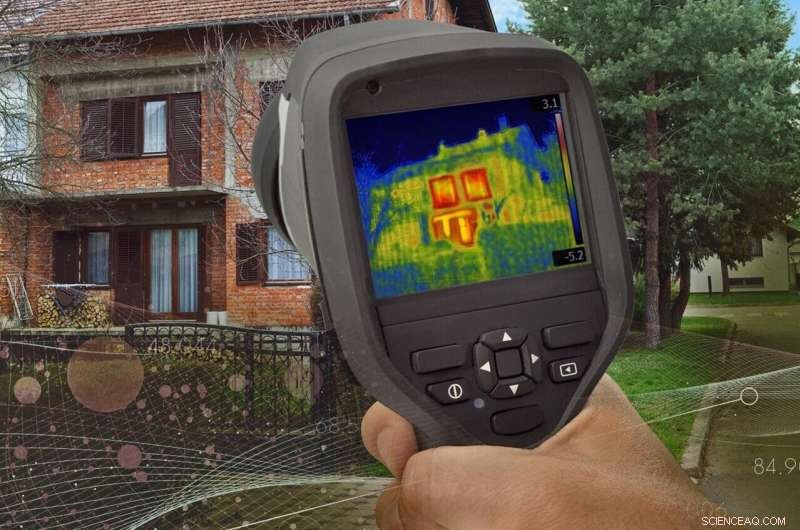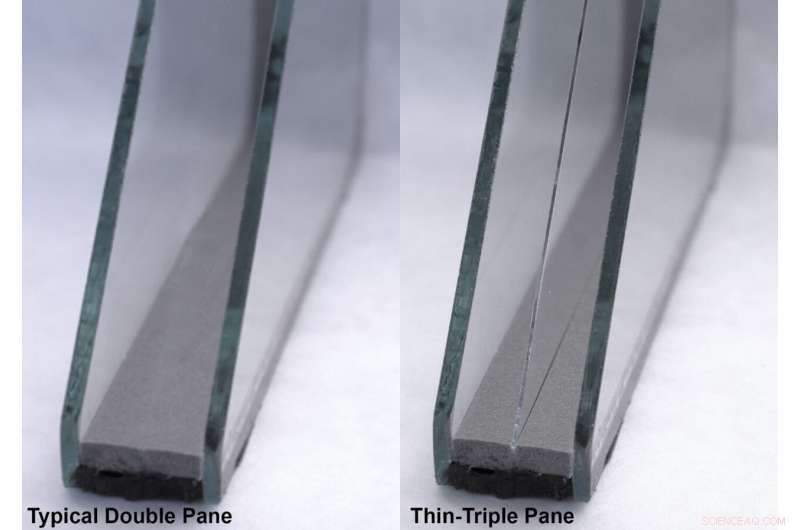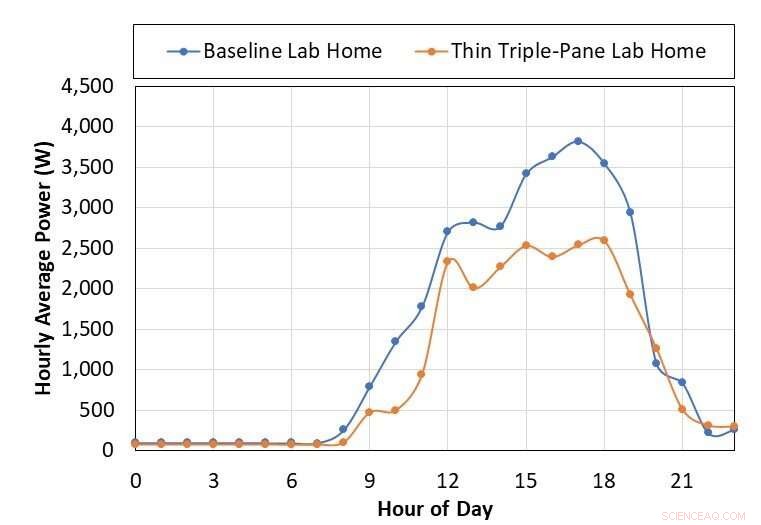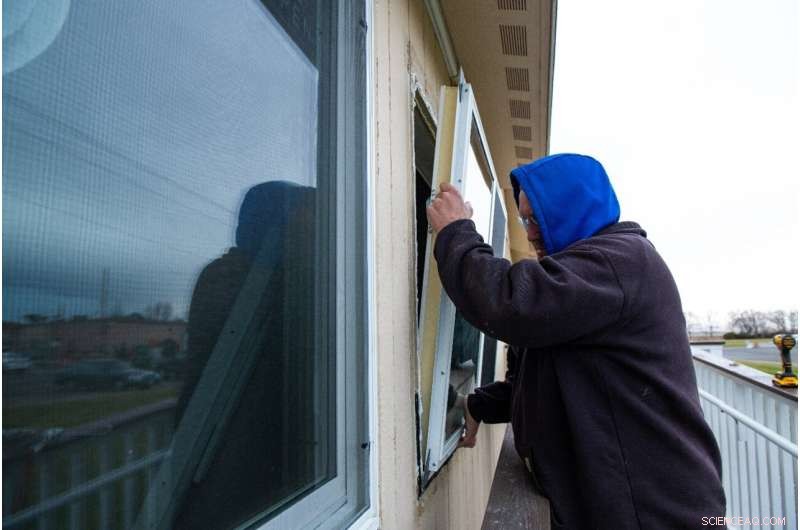
La tecnologia di imaging a infrarossi (IR) (mostrata qui) è uno degli strumenti utilizzati per misurare la perdita di calore attraverso finestre scarsamente isolate. Una serie di studi di ricerca mostra che una nuova generazione di finestre a triplo vetro può aiutare a migliorare l'efficienza energetica nelle case. Credito:Timothy Holland | Laboratorio nazionale del Pacifico nord-occidentale
È ora di passare alle finestre a triplo riquadro. Questo è il messaggio di una serie di studi condotti dal Pacific Northwest National Laboratory del Dipartimento dell'Energia in collaborazione con una coalizione di partner pubblici e privati.
"Costi inferiori, maggiore disponibilità e la spinta a ridurre le emissioni di carbonio ci stanno spingendo verso un punto di svolta in cui le finestre a triplo vetro iniziano ad avere molto senso economico", ha affermato Kate Cort, economista ricercatore presso PNNL e responsabile del programma per il campo in corso studi di convalida di finestre a triplo riquadro.
Non è un segreto che le finestre di una casa possono sprecare molta energia. Possono perdere aria e anche gli ultimi modelli di finestre a doppio vetro contribuiscono in modo significativo al consumo energetico e ai costi di una casa. Per una nuova casa, le finestre in genere costituiscono circa l'8% della superficie esterna, ma sono responsabili della metà della perdita o del guadagno di calore. Questa perdita di energia passiva rende le finestre un importante contributo ai costi di riscaldamento e raffreddamento della casa.
Nel frattempo, le prove del risparmio energetico e dei costi delle finestre a triplo vetro si stanno lentamente sviluppando da anni, da quando sono stati introdotti i primi prototipi intorno al 1989. Studi precedenti hanno dimostrato che le finestre a triplo vetro sono più efficienti dal punto di vista energetico rispetto alle doppie finestre standard del settore varietà di pannelli, ma l'adozione sul mercato è stata lenta a causa dei costi e della disponibilità.
Questi aspetti negativi stanno per cambiare, ha detto Cort. Una nuova generazione di sottili finestre a triplo vetro è meno costosa e può essere più facilmente adattata ai telai a doppio vetro esistenti. Come suggerisce il nome, le finestre a triplo vetro hanno tre lastre di vetro che creano un sandwich a due piani, che viene riempito con un gas inerte, come il krypton, che fornisce ulteriore potere isolante. Queste finestre di nuova generazione sfruttano le economie di scala fornite dalla stessa tecnologia avanzata di produzione del vetro che sforna TV e schermi di computer sottili ma durevoli.
Negli ultimi tre anni, Cort e i suoi colleghi hanno valutato sistematicamente i risparmi energetici ei fattori economici che determineranno la velocità con cui verranno accettati dai costruttori. Questo lavoro è stato supportato dal DOE Building Technologies Office e dalla Bonneville Power Administration.
Ora le autorità di regolamentazione statali stanno iniziando a prenderne atto. Di recente, lo stato del Michigan ha utilizzato i dati di uno studio sul campo PNNL sulle finestre a triplo vetro per includerli nell'elenco del manuale delle risorse tecniche dello stato delle misure approvate di risparmio energetico ammissibili a incentivi e sconti di utilità.
I nuovi standard energetici creano urgenza
Un altro studio recente condotto da Cort, dal collega del PNNL Edward Louie e da Robert Hart del Lawrence Berkeley National Laboratory ha dimostrato che per la costruzione di nuove case, le finestre a triplo vetro possono aiutare i costruttori a soddisfare in modo economico codici energetici 2021 più severi per le nuove case. Il loro studio, pubblicato nel numero di marzo 2022 di ASHRAE Journal ha mostrato che quando un costruttore di edifici aggiorna le finestre di una nuova casa da doppi a tripli vetri, le prestazioni di efficienza energetica delle finestre possono migliorare del 40% o più. Questa prestazione aggiuntiva aumenta il valore isolante totale dell'intero esterno della casa, spesso indicato come involucro edilizio.
"Il nostro studio ha dimostrato che l'aumento dell'efficienza energetica delle finestre offre ai costruttori una maggiore flessibilità nella progettazione e la possibilità di fare compromessi con altri componenti dell'involucro, come l'isolamento delle pareti esterne, rispettando il codice", ha affermato Cort. L'effetto complessivo è quello di fornire ai costruttori più opzioni e una migliore garanzia di conformità al codice edilizio, migliorando al contempo il comfort per i proprietari di case.

Thin triple-pane windows (right) have three panes of glass filled with an inert gas, krypton, and coated with a low-emission film to enhance energy efficiency. Credit:Lawrence Berkeley National Laboratory
What's the hold up for triple-pane windows?
Builders play a key role in the adoption of new home building technologies, said Cort. In 2020, she and her colleagues interviewed 29 home builders who have participated in the DOE Zero Energy Ready Home program. They asked builders to explain their decision-making process for window selection during the 2018 to 2019 building season. Forty-one percent of these builders used triple‐pane windows in all their new homes and another 28% in most or some of their homes. For those who didn't use triple-pane windows, the biggest factor was cost.
"The price differential between double-pane and triple-pane windows has been a pain-point for builders," Cort noted. But she added that the increased incremental material cost of triple-pane windows is now about $700 to $2,400 for a 2,400-square-foot wood-framed home. This is about the same cost as adding an extra inch of rigid wall insulation to the same home.
Some builders also stated that the indirect cost of custom installation for triple-pane windows, which can be 25% to 50% heavier than similar sized double‐pane windows, also weighed into their choice.
"Most builders aren't familiar with the newer thinner, lighter triple-pane technology," said Cort. But the survey showed most would be willing to try them if the cost and availability made it practical for them.

Thin triple-pane windows greatly reduced the power usage by the air-conditioning system in the hottest part of the day, compared with standard double-pane windows. The direct comparison was made in identical custom Lab Homes on the PNNL campus in summer 2020. Credit:Katherine Cort | Laboratorio nazionale del Pacifico nord-occidentale
Some of the builders Cort's team interviewed noted that consumers like the comfort and quiet of triple-pane windows. A recent study confirmed that the installation of thin triple-panes reduced the sound infiltration by an average of 8-10 decibels when compared to the home with double-pane metal-frame windows, which roughly equates to reducing the perceived noise level by half.
"When someone comes into the house and you shut the door, it's like getting into a Mercedes or BMW," said a Seattle builder. "It's so solid and quiet. We are building homes next to Boeing Field airport in Seattle. Planes are flying right overhead so close you can clearly see them from the houses, and it is so quiet inside you can't hear them."
Demonstration projects lead the way
When there are new approaches to home building, said Cort, builders need assurances that materials will be available when needed, hold up under use, and deliver on promised improvements.
To help meet those expectations, PNNL has joined forces with DOE, Lawrence Berkley National Laboratory, and the Northwest Energy Efficiency Alliance to launch the Partnership for Advanced Window Solutions. With support from DOE, this public-private partnership is working with builders, utilities, and manufacturers to both drive demand and scale up production of cost-effective "drop-in" thin triple-pane window designs and other high-performance window solutions.

Installers insert thin triple-pane windows at a PNNL Lab Home, custom model homes on the PNNL campus built to conduct energy efficiency research. Credito:Andrea Starr | Laboratorio nazionale del Pacifico nord-occidentale
The PNNL team recently compared the energy efficiency performance of these windows in its Lab Homes, a pair of identical manufactured homes used to study energy efficiency. During the winter heating season of 2019 and the summer cooling season of 2020, researchers recorded energy usage and temperatures throughout the homes. During the two 10-week evaluation periods, the windows saved an average of 12% on heating and 28% on cooling for the 1,500-square-foot structures. In addition, the home with the triple-pane windows reduced outdoor noise and maintained much more comfortable and even temperatures throughout the home during both summer and winter testing periods.
The research team is now field testing the windows in 10 locations nationwide, from manufactured homes in Pasco, Wash., to a net-zero apartment complex in Rotterdam, N.Y. In these field demonstration projects, the incremental cost over standard ENERGY STAR windows was $6 per square foot or less, said Cort. Within the last year, multiple versions of the thin-glass triple-pane units have been developed, certified by the National Fenestration Rating Council, and have become available to builders.
"At this point, it's a matter of increasing awareness among manufacturers, builders, utility programs, and consumers," said Cort. "It's time to look at windows, not just through them."